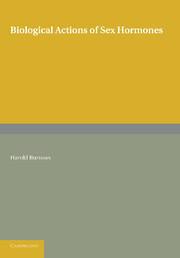Book contents
- Frontmatter
- CONTENTS
- PREFACE
- PART I GONADOTROPHINS
- CHAPTER I The Nature and Functions of Gonadotrophins
- CHAPTER II Factors which Influence the Gonadotrophic Activity of the Pituitary
- CHAPTER III Factors which influence the Reaction of the Gonads to Gonadotrophins
- CHAPTER IV Factors which affect the Cytological Structure and Weight of the Anterior Lobe of the Pituitary
- PART II GONADAL HORMONES
- PART III ANDROGENS
- PART IV OESTROGENS
- PART V PROGESTINS
- PART VI SEX HORMONES OF THE ADRENAL CORTEX
- APPENDIX
- REFERENCES
- GLOSSARY
- INDEX
CHAPTER III - Factors which influence the Reaction of the Gonads to Gonadotrophins
from PART I - GONADOTROPHINS
Published online by Cambridge University Press: 05 June 2016
- Frontmatter
- CONTENTS
- PREFACE
- PART I GONADOTROPHINS
- CHAPTER I The Nature and Functions of Gonadotrophins
- CHAPTER II Factors which Influence the Gonadotrophic Activity of the Pituitary
- CHAPTER III Factors which influence the Reaction of the Gonads to Gonadotrophins
- CHAPTER IV Factors which affect the Cytological Structure and Weight of the Anterior Lobe of the Pituitary
- PART II GONADAL HORMONES
- PART III ANDROGENS
- PART IV OESTROGENS
- PART V PROGESTINS
- PART VI SEX HORMONES OF THE ADRENAL CORTEX
- APPENDIX
- REFERENCES
- GLOSSARY
- INDEX
Summary
Age. Season. Nature and mode of preparation of the gonadotrophin. Synergism and augmentation. Delayed absorption. Divisional dosage. Site of introduction. Acquired resistance to the action of gonadotrophin. Difference in responses by different species. Temperature.
Age
Tests for pregnancy in women, which depend on the presence of gonadotrophin in the urine, have shown incidentally that precocious puberty can be induced in mice and rats by supplying gonadotrophin in excess. It follows that the gonads of these animals can respond to gonadotrophin at a date which precedes the normal onset of puberty. From this and other experimental facts already quoted it may be assumed that puberty in normal circumstances depends mainly on the quantity or quality of gonadotrophin produced. Nevertheless the reactivity of the gonads must be considered, for there is, in some animals at least, an early stage of postnatal life during which the gonads will not respond to gonadotrophin in the same way as they would later on. When we review the experimental work on which these remarks are founded, it becomes apparent that the interstitial glandular elements of the gonads will react to gonadotrophin at a stage of development when the germinal elements still fail to do so.
(a) Early responsiveness of the glandular interstitial cells of the gonads to gonadotrophin. That the interstitial gonadal tissue may become susceptible to stimulation by gonadotrophin at a stage of life when the germinal tissues are inert was shown by Domm (1931), who implanted fowl pituitaries daily into immature brown leghorn chicks, beginning when they Were between 28 and 59 days old. These implants caused enlargement of the gonads and accessory sexual structures, including hypertrophy of the oviduct and comb, while the ovarian follicles and seminal tubules remained unaffected; the interstitial glandular elements in the gonads of both males and females were not only enlarged, but were functionally active. Domm & Van Dyke (1932) amplified these experiments and obtained the same results, except that they found the ovarian follicles were somewhat larger than in controls, though there was no maturation.
- Type
- Chapter
- Information
- Biological Actions of Sex Hormones , pp. 70 - 84Publisher: Cambridge University PressPrint publication year: 2013

